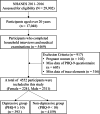Association between serum copper, zinc, and selenium concentrations and depressive symptoms in the US adult population, NHANES (2011-2016)
- PMID: 37434135
- PMCID: PMC10337172
- DOI: 10.1186/s12888-023-04953-z
Association between serum copper, zinc, and selenium concentrations and depressive symptoms in the US adult population, NHANES (2011-2016)
Abstract
Background: Evidence suggests that alterations in serum trace element concentrations are closely associated with mental illness. However, studies on the relationship between serum copper, zinc, and selenium concentrations and depressive symptoms are limited and with controversial results. We aimed to investigate the association between serum concentrations of these trace elements and depressive symptoms in US adults.
Methods: Data from the National Health and Nutrition Examination Survey (NHANES) (2011-2016) were used in this cross-sectional study. The Patient Health Questionnaire-9 Items (PHQ-9) was employed to assess depressive symptoms. Multiple logistic regression was performed to determine the relationship between the serum concentrations of copper, zinc, and selenium and depressive symptoms.
Results: A total of 4552 adults were included. Subjects with depressive symptoms had higher serum copper concentrations (123.88 ± 1.87) than those without depressive symptoms (116.99 ± 0.86) (p < 0.001). In Model 2, weighted logistic regression analysis showed that the second (Q2) quartile of zinc concentrations (odds ratio [OR] = 1.534, 95% confident interval [CI]: 1.018 to 2.313) were significantly associated with an increased risk of depressive symptoms. Subgroup analysis revealed that the third (Q3) and fourth (Q4) quartiles of copper concentrations (Q3: OR = 2.699, 95% CI: 1.285 to 5.667; Q4: OR = 2.490, 95% CI: 1.026 to 6.046) were also positively associated with depressive symptoms in obese individuals after controlling for all confounders. However, no significant relationship between serum selenium concentrations and depressive symptoms was observed.
Conclusions: Obese US adults with high serum copper concentrations, as well as US adults in general with low serum zinc concentrations, were susceptible to depressive symptoms. Nevertheless, the causal mechanisms underlying these relationships need to be further explored.
Keywords: Copper; Depression; Micronutrients; NHANES; Selenium; Zinc.
© 2023. The Author(s).
Conflict of interest statement
The authors declare no competing interests.
Figures
Similar articles
-
Association between serum zinc levels and suicidal ideation in US adults: A population-based cross-sectional study.J Affect Disord. 2023 May 15;329:359-368. doi: 10.1016/j.jad.2023.02.039. Epub 2023 Feb 17. J Affect Disord. 2023. PMID: 36801424
-
Associations of serum zinc, copper, and selenium with sleep disorders in the American adults: Data from NHANES 2011-2016.J Affect Disord. 2023 Feb 15;323:378-385. doi: 10.1016/j.jad.2022.11.088. Epub 2022 Dec 2. J Affect Disord. 2023. PMID: 36464094
-
BMI Modifies the Association Between Depression Symptoms and Serum Copper Levels.Biol Trace Elem Res. 2023 Sep;201(9):4216-4229. doi: 10.1007/s12011-022-03505-y. Epub 2022 Nov 27. Biol Trace Elem Res. 2023. PMID: 36437432
-
The role of copper, molybdenum, selenium, and zinc in nutrition and health.Clin Lab Med. 1998 Dec;18(4):673-85. Clin Lab Med. 1998. PMID: 9891606 Review.
-
Selenium and Other Trace Elements in the Etiology of Parkinson's Disease: A Systematic Review and Meta-Analysis of Case-Control Studies.Neuroepidemiology. 2020;54(1):1-23. doi: 10.1159/000502357. Epub 2019 Aug 27. Neuroepidemiology. 2020. PMID: 31454800
Cited by
-
A Cross-Sectional Study to Assess the Level of Antioxidant Ascorbic Acid (Vitamin C) in Diagnosed Patients of Depression at Tertiary Care Hospital of Central India.J Pharm Bioallied Sci. 2025 May;17(Suppl 1):S642-S645. doi: 10.4103/jpbs.jpbs_1633_24. Epub 2025 Feb 15. J Pharm Bioallied Sci. 2025. PMID: 40510983 Free PMC article.
-
Biomarkers in the Diagnosis and Prediction of Medication Response in Depression and the Role of Nutraceuticals.Int J Mol Sci. 2024 Jul 22;25(14):7992. doi: 10.3390/ijms25147992. Int J Mol Sci. 2024. PMID: 39063234 Free PMC article. Review.
-
Association between blood lead, cadmium, selenium levels and hyperlipidemia: A population-based study.PLoS One. 2024 Aug 15;19(8):e0306573. doi: 10.1371/journal.pone.0306573. eCollection 2024. PLoS One. 2024. PMID: 39146272 Free PMC article.
-
Mineral Homeostasis and Depression: Implications for Prevention and Therapeutic Support-A Narrative Review.Int J Mol Sci. 2025 Jul 10;26(14):6637. doi: 10.3390/ijms26146637. Int J Mol Sci. 2025. PMID: 40724885 Free PMC article. Review.
-
Genetic Causal Associations between Various Serum Minerals and Risk of Depression: A Mendelian Randomization Study.Actas Esp Psiquiatr. 2024 Jun;52(3):211-220. doi: 10.62641/aep.v52i3.1637. Actas Esp Psiquiatr. 2024. PMID: 38863045 Free PMC article.
References
-
- GBD 2017 Disease and Injury Incidence and Prevalence Collaborators. Global, Regional, Incidence N. Prevalence, and years lived with disability for 354 Diseases and Injuries for 195 countries and Territories, 1990–2017: a systematic analysis for the global burden of Disease Study 2017. Lancet (London England) 2018;392(10159):1789–858. doi: 10.1016/s0140-6736(18)32279-7. - DOI - PMC - PubMed
Publication types
MeSH terms
Substances
LinkOut - more resources
Full Text Sources
Medical


